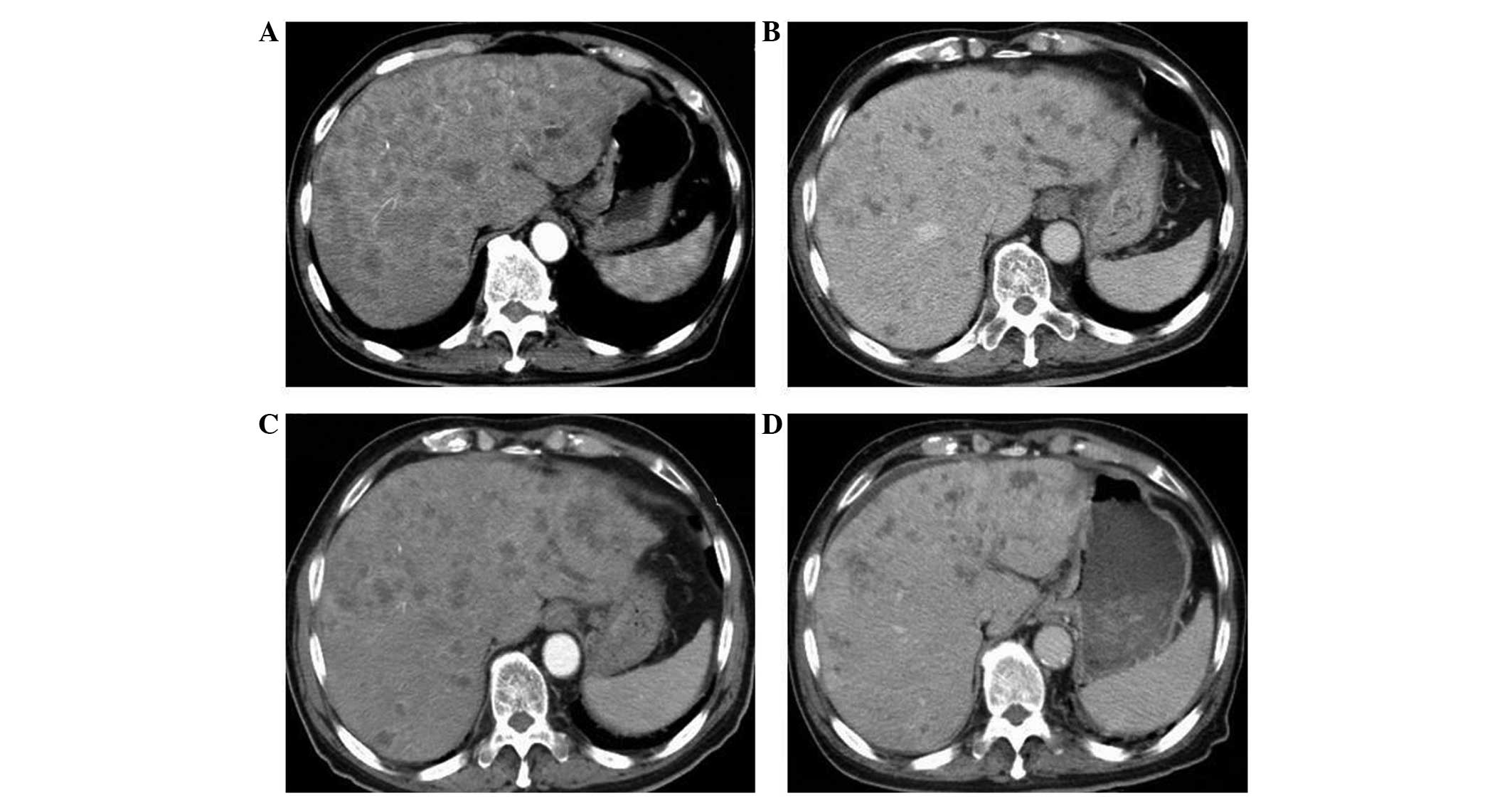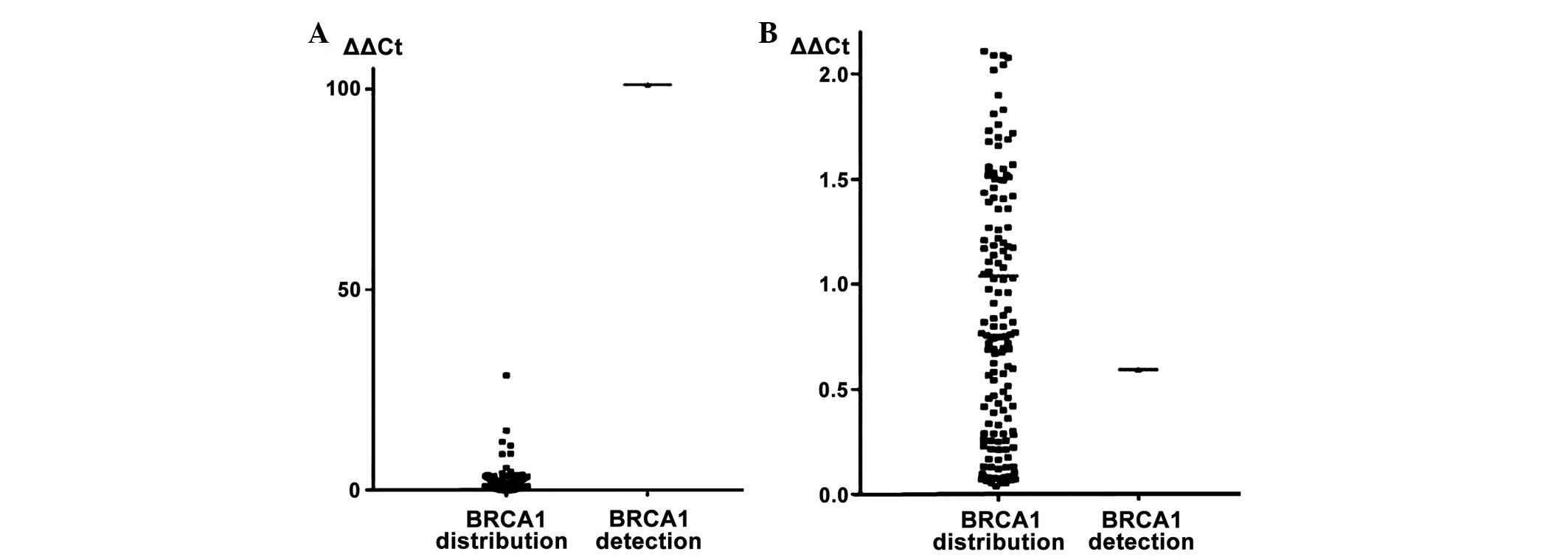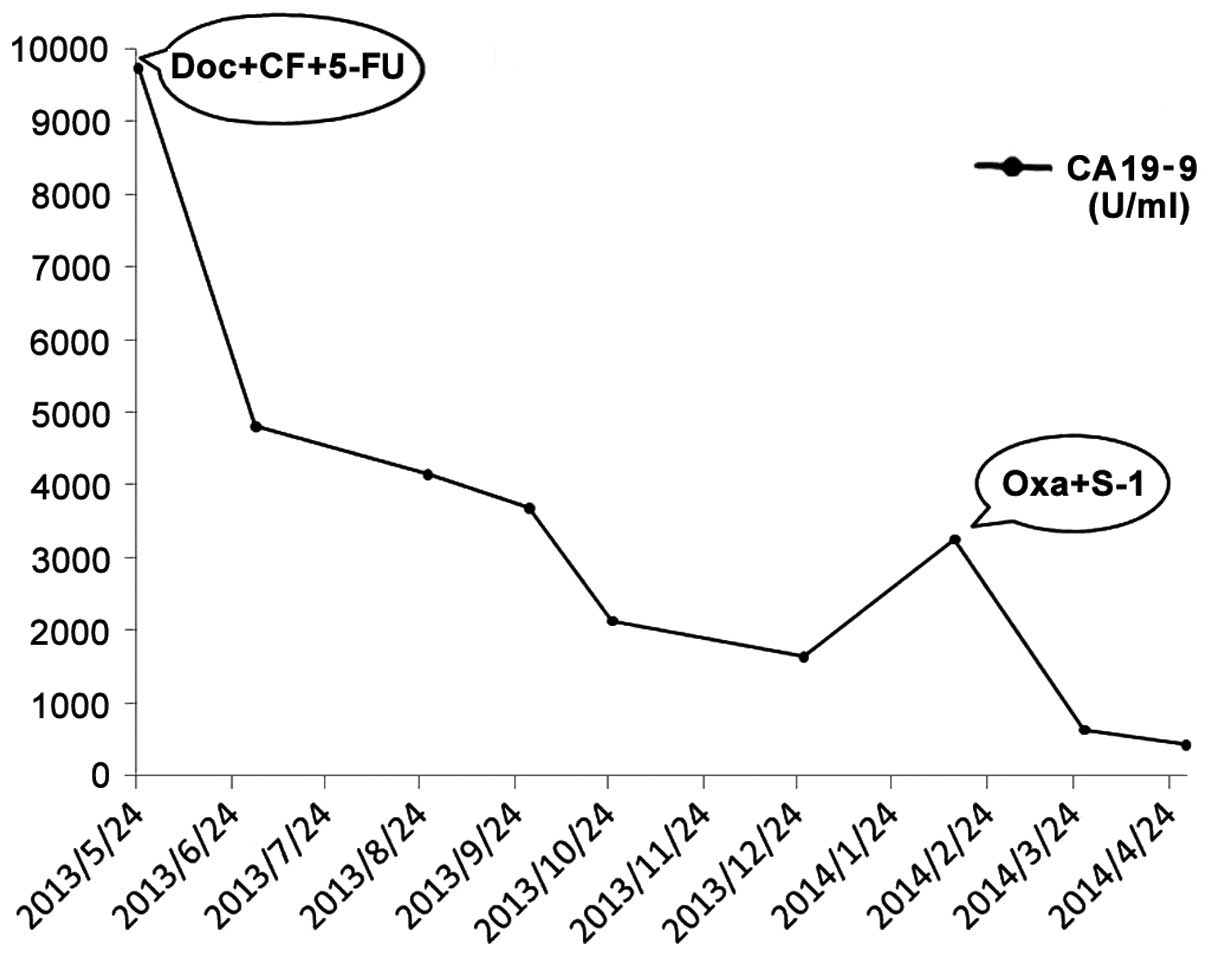Introduction
The median overall survival (OS) time of patients
with metastatic gastric cancer is only ~4 months, and the median
overall survival time of such patients who are >75 years old is
<3 months (1). Personalized
chemotherapy delivers the appropriate care to the correct patient
at the right time and results in measurable improvements in
outcomes (2). Breast cancer 1 (BRCA1)
acts mainly in the response to DNA damage by participating in DNA
repair, cell cycle regulation, mRNA transcription, and protein
ubiquitination and SUMOylation, and in the response to
antimicrotubules by regulating the spindle checkpoint (3). A growing amount of evidence has
indicated that low BRCA1 expression confers increased sensitivity
to DNA-damaging chemotherapeutic agents, including cisplatin and
oxaliplatin, while high BRCA1 expression leads to sensitivity to
mitotic spindle poisons, such as docetaxel (4). The BRCA1 gene has been identified as a
useful predictive marker for chemotherapeutic choice in breast
cancer, ovarian cancer or non-small cell lung cancer (NSCLC). A
recent study showed a beneficial effect of second-line
docetaxel-based chemotherapy on the survival of patients with
advanced-stage gastric cancer (5).
Another study indicated that plasma BRCA1 mRNA expression levels
may also have a promising role as potential predictive biomarkers
for chemotherapy (6). The present
study describes BRCA1-specific gastric cancer in a patient who was
twice treated with personalized chemotherapy base on quantitative
gene expression data. Written informed consent was obtained from
the patient for publication of this case report and any
accompanying images.
Case report
A 77-year-old man presented to Nanjing Drum Tower
Hospital (Nanjing, Jiangsu, China) on May 21, 2013, due to
epigastric discomfort, bloating and melena that had persisted for 1
month. Gastroscopy demonstrated a huge ulcer in the gastric cardia
and body. Examination of a biopsy specimen showed the presence of
poorly differentiated adenocarcinoma. The expression of human
epidermal growth factor receptor-2 was negative. Computed
tomography scans revealed massive liver metastases (Fig. 1A). The largest metastatic lesions were
located in the right lobe of the liver and its diameter was ~1.3cm.
The patient's carbohydrate antigen (CA) 19-9 tumor marker level was
9,736 U/ml (normal range, 0-39 U/ml). Other tumor markers,
including CA12-5, CA242, CA72-4, carcinoembryonic antigen and
alpha-fetoprotein were tested. CA12-5 (59.7 U/ml; normal range,
0–30.2 U/ml) and CA242 (27.9 U/ml; normal range, 0–15 U/ml) levels
were slightly abnormal. The medical history included a 10-year
history of hypertension and type 2 diabetes, and surgeries
consisting of a cholecystectomy in 1989, prostatectomy in 2010 and
phacoemulsification in 2013. The current diagnosis was of advanced
gastric cancer with liver metastases.
A high BRCA1 mRNA expression level in the peripheral
blood was first detected in March 2013 by quantitative polymerase
chain reaction (qPCR) (Fig. 2A).
Briefly, RNA was extracted using a proteinase K-containing buffer
(Applied Biosystems; Thermo Fisher Scientific, Inc., Waltham, MA,
USA) and treated with DNAse I (Applied Biosystems; Thermo Fisher
Scientific, Inc.). Template cDNA was amplified with specific
primers and probes for β-actin and BRCA1 and Taqman Universal
Master Mix (Applied Biosystems; Thermo Fisher Scientific, Inc.).
The primers and probes (Applied Biosystems; Thermo Fisher
Scientific, Inc.) were as follows: β-actin, forward
5′-TGAGCGCGGCTACAGCTT-3′, reverse 5′-TCCTTAATGTCACGCACGATTT-3′ and
probe 6FAM-5′-ACCACCACGGCCGAGCGG-3′-TAMRA; BRCA1, forward
5′-GGCTATCCTCTCAGAGTGACATTTTA-3′, reverse
5′-GCTTTATCAGGTTATGTTGCATGGT-3′ and probe
6FAM-5′-CCACTCAGCAGAGGG-3′-MGB. qPCR was performed using the ABI
Prism 7900HT Sequence Detection System (Applied
Biosystems®; Thermo Fisher Scientific, Inc.) under the
following conditions: 50°C for 2 min, 95°C for 10 min, followed by
45 cycles at 95°C for 15 sec and 60°C for 1 min. The experiments
were performed three times and the quantification of relative gene
expression was according to the comparative Cq method using β-actin
as an endogenous control (7).
According to this methodology, final values were determined using
the formula 2-ΔΔCq = 2-(ΔCq sample-ΔCq calibrator),
where ΔCq values of the calibrator and sample are determined by
subtracting the Cq value of the target gene from the value of the
β-actin gene. All analyses were performed at The Comprehensive
Cancer Center of Nanjing Drum Tower Hospital, The Affiliated
Hospital of Nanjing University Medical School (Nanjing, China).
Due to the high BRAC1 mRNA levels, the patient was
administered personalized chemotherapy using a docetaxel + calcium
folinate + 5-fluorouracil (5-FU) drug regimen (docetaxel, 35
mg/m2 on day 1; folinic acid, 200 mg/m2 as a
2 h infusion on day 1; 5-FU, 600 mg/m2 22 h infusion on
days 1 and 2; every two weeks). After 2 cycles of chemotherapy, the
metastatic liver lesions responded partially (Fig. 1B) and the level of tumor marker CA19-9
concomitantly declined markedly (4146 U/ml). However, the
metastatic liver lesions progressed after 7 cycles of treatment
(Fig. 1C), and at the same time,
there was a rebound in the level of the tumor marker (CA19-9, 3252
U/ml). qPCR was performed again in February 2014 for BRCA1 mRNA
level, and the result was completely different from the first time,
showing that the BRCA1 mRNA expression level was now low (Fig. 2B). The patient was subsequently
administered further personalized chemotherapy using a combination
of oxaliplatin and S-1 (oxaliplatin, 85 mg/m2 on day 1;
S-1, 40 mg/m2 twice a day on day 1–4; every two weeks).
As a consequence, the metastatic liver lesions stabilized again
(Fig. 1D). The levels of tumor marker
during the whole treatment are shown in Fig. 3. Since April 2014 the patient was yet
to receive two cycles of oxaliplatin and S-1 chemotherapy. The
patient refused further treatment and was lost to follow-up.
Discussion
The present study reports a case of personalized
chemotherapy based on quantitative gene expression data. The
patient was >75 years old, had presented with several primary
diseases and was in poor health. The patient has currently remained
alive for almost 2 years post-diagnosis of advanced gastric cancer.
The clinical benefits that were obtained from personalized
chemotherapy based on BRCA1 mRNA expression is notable. Certain
studies have shown that BRCA1 mRNA expression modulates
chemosensitivity to chemotherapeutic agents in DNA repair, by
recruiting BRCA1-A complex subunit RAP80, protein inhibitor of
activated STAT family of proteins and BRCA1/BRCA1-associated RING
domain 1 heterodimer (8). It is
important for patients to receive secondary detection of BRAC1 mRNA
expression levels in peripheral blood. qPCR tests for secondary
BRCA1 mRNA expression in docetaxel-treated cancers with high BRCA1
expression may be clinically important, as tumors with altered
BRCA1 expression, such as in the present study, are likely to be
sensitive to oxaliplatin. Quinn et al (4) suggest that sporadic epithelial ovarian
cancer patients with low levels of BRCA1 mRNA expression may obtain
therapeutic benefit from platinum chemotherapy agents, whereas
patients with higher levels of BRCA1 potentially have an improved
response to regimens containing taxanes. Larger clinical studies
are warranted to further determine the prevalence and clinical
significance of the secondary expression of BRCA1 in BRCA1-specific
cancer. The present findings could have implications for gastric
cancers with regard to gene detection and clinical application.
Moreover, altered BRCA1 expression may predict differential
chemosensitivity to different anticancer drugs, which is
advantageous when compared with molecular-targeted therapy. For
example, a comprehensive review has shown that k-RAS mutations
confer a high level of resistance to EGFR-targeting strategies in
patients with either metastatic colorectal cancer or NSCLC
(9). Therefore, BRCA1 may not only be
associated with chemotherapeutic sensitivity to first-line
treatment, but may also be a useful and quantitative biomarker for
acquired BRCA1-resistant cancer, which should enhance efficiency in
customized chemotherapy.
In the present case, the clinical benefits achieved
by an older patient who was in poor bad health indicated that
customized chemotherapy based on the monitoring of quantitative
BRCA1 mRNA expression may provide a promising treatment for those
patients presenting with metastatic gastric cancer, even following
resistance.
References
|
1
|
Yang D, Hendifar A, Lenz C, Togawa K, Lenz
F, Lurje G, Pohl A, Winder T, Ning Y, Groshen S and Lenz HJ:
Survival of metastatic gastric cancer: Significance of age, sex and
race/ethnicity. J Gastrointest Oncol. 2:77–84. 2011.PubMed/NCBI
|
|
2
|
Ng PC, Murray SS, Levy S and Venter JC: An
agenda for personalized medicine. Nature. 461:724–726. 2009.
View Article : Google Scholar : PubMed/NCBI
|
|
3
|
Morris JR, Boutell C, Keppler M, Densham
R, Weekes D, Alamshah A, Butler L, Galanty Y, Pangon L, Kiuchi T,
et al: The SUMO modification pathway is involved in the BRCA1
response to genotoxic stress. Nature. 462:886–890. 2009. View Article : Google Scholar : PubMed/NCBI
|
|
4
|
Quinn JE, James CR, Stewart GE, Mulligan
JM, White P, Chang GK, Mullan PB, Johnston PG, Wilson RH and Harkin
DP: BRCA1 mRNA expression levels predict for overall survival in
ovarian cancer after chemotherapy. Clin Cancer Res. 13:7413–7420.
2007. View Article : Google Scholar : PubMed/NCBI
|
|
5
|
Wei J, Costa C, Ding Y, Zou Z, Yu L,
Sanchez JJ, Qian X, Chen H, Gimenez-Capitan A, Meng F, et al: mRNA
expression of BRCA1, PIAS1 and PIAS4 and survival after second-line
docetaxel in advanced gastric cancer. J Natl Cancer Inst.
103:1552–1556. 2011. View Article : Google Scholar : PubMed/NCBI
|
|
6
|
Shen J, Wei J, Guan W, Wang H, Ding Y,
Qian X, Yu L, Zou Z, Xie L, Costa C, et al: Plasma mRNA expression
levels of BRCA1 and TS as potential predictive biomarkers for
chemotherapy in gastric cancer. J Transl Med. 12:3552014.
View Article : Google Scholar : PubMed/NCBI
|
|
7
|
Livak KJ and Schmittgen TD: Analysis of
relative gene expression data using real-time quantitative PCR and
the 2(−Delta Delta C(T)) Method. Methods. 25:402–408. 2001.
View Article : Google Scholar : PubMed/NCBI
|
|
8
|
Sobhian B, Shao G, Lilli DR, Culhane AC,
Moreau LA, Xia B, Livingston DM and Greenberg RA: RAP80 targets
BRCA1 to specific ubiquitin structures at DNA damage sites.
Science. 316:1198–1202. 2007. View Article : Google Scholar : PubMed/NCBI
|
|
9
|
Linardou H, Dahabreh IJ, Kanaloupiti D,
Siannis F, Bafaloukos D, Kosmidis P, Papadimitriou CA and Murray S:
Assessment of somatic k-RAS mutations as a mechanism associated
with resistance to EGFR-targeted agents: A systematic review and
meta-analysis of studies in advanced non-small-cell lung cancer and
metastatic colorectal cancer. Lancet Oncol. 9:962–972. 2008.
View Article : Google Scholar : PubMed/NCBI
|

















